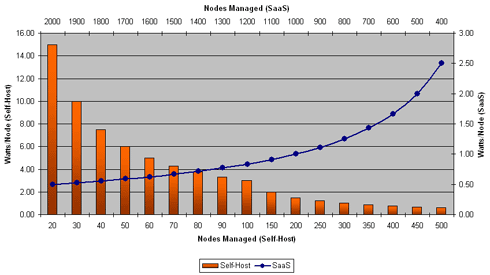First off, "green" is a pretty relative term when you're talking about lighting up 500W displays all over the place. But the key question, "Does software-as-a-service use more or less power than a self-hosted and locally-managed application delivery" seems valid enough. And certainly my initial guess was "yes, it must be, since there should be fewer computers providing the service." Still, I hadn't done the math, and since the company I was speaking to has a big reputation for taking their projects green, I didn't want to screw up. After spending a little time doing some research and plenty of guesswork, I came up with some not-unbelievable yet not-terribly-satisfying figures that I thought I'd share and get some feedback on.
Assumptions, please
You know what happens when people go assuming, right? They make an ass out of u and Ming (and if Flash Gordon has taught us anything, it's a bad idea to piss off Ming). Unfortunately there's no way that somebody could figure out an industry-wide average for things like server density, utilization ratios and power consumption without making some guesses, so here are mine:
- The average network has 100 nodes (media players) attached. I actually think this is on the high side, with a more realistic estimate being in the 30-40 range, but in this experiment it's more conservative to round up rather than down (you'll see why in a minute).
- It only takes one server to run a 100-node network. That means that everything -- management application, database, connection manager, etc. is running off of the same machine. That seems reasonable for only 100 units.
- The typical self-hosted server draws 300W, and is turned on 24/7. You don't need the beefiest machine in the world to manage a 100 node network, so that seems reasonable.
- The typical SaaS server cluster can manage 2,000 nodes. I'm drawing on personal experience here. If you forget about multi-cluster redundancy for a minute (which seems fair since we haven't figured in redundant servers for the self-hosted option), a "cluster" in my parlance is two servers: an application server and a database server.
- Each SaaS cluster draws 1,000W, and is turned on 24/7.

So, based on the math above, a SaaS infrastructure may be six times as efficient as a self-hosted infrastructure on a watts-per-unit basis.
It's all about density, baby
There are plenty of places to take a wrong turn above, and since a good chunk of my company's revenues come from providing digital signage SaaS solutions, I thought it prudent to point out just how far off-the-mark the above calculations could be if we vary the assumptions a bit. The key is server density -- how many nodes you can manage on a single machine (or cluster) without it going up in smoke. I think my estimates for server wattage and the nodes/cluster for SaaS are pretty accurate, since those are all things I have first-hand experience with. But when it comes to the total number of nodes managed on a given server, as I noted above, my estimate's as good as the next guy's. Look what happens when you vary that number:

So you can see that at higher numbers, the efficiency of a self-host solution starts to approach that of a well-utilized SaaS cluster (assuming you can cram the management of 500 nodes onto a single low-power server) . Likewise, underutilized SaaS clusters, because of their high base power requirements, rate low for power efficiency -- a SaaS cluster managing only 400 nodes (i.e. a few small customers) isn't much better off than a customer hosting their own server for 100 nodes.
What are the real-world implications of this?
Going back to our original set of assumptions, let's add in some data from iSuppli that shows that 758,000 nodes of digital signage were deployed to the retail sector in 2008. This total would require either 7,580 individual servers each managing 100 nodes (for a total power draw of 2,274 KW), or 379 hypothetical SaaS clusters (which would draw only 379 KW). To put that in perspective, the difference is enough to power about 1,500 homes. If iSuppli's projections are accurate and we see the market size triple to 2.5M nodes in 2013, the consumption differences and savings would roughly triple as well.
Ultimately, the difference simply isn't that large, especially when you consider that those same hundred screens requiring a 300W server are each drawing 200-300W themselves. So at this point, I'd be willing to say that when it comes to digital signage, a well-managed SaaS infrastructure is likely to be more electricity-efficient than a typical self-hosted solution. However, the difference is fairly modest, varies from network to network, and is certainly not something I'll be putting into my sales pitch any time in the near future :)
When it comes to digital signage, how important do you think it is to be green?


 Subscribe to the Digital Signage Insider RSS feed
Subscribe to the Digital Signage Insider RSS feed
Comments
RSS feed for comments to this post